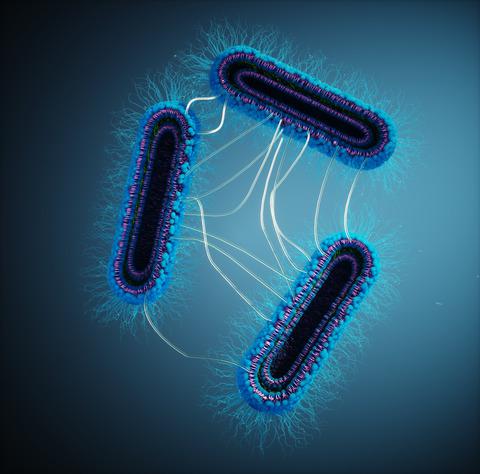当前位置:
X-MOL 学术
›
Mol. Microbiol.
›
论文详情
Our official English website, www.x-mol.net, welcomes your
feedback! (Note: you will need to create a separate account there.)
Bacterial glycocalyx integrity drives multicellular swarm biofilm dynamism
Molecular Microbiology ( IF 2.6 ) Pub Date : 2021-08-29 , DOI: 10.1111/mmi.14803 Fares Saïdi 1, 2 , Nicolas Y Jolivet 1, 2 , David J Lemon 3 , Arnaldo Nakamura 1 , Akeisha M Belgrave 4 , Anthony G Garza 3 , Frédéric J Veyrier 1 , Salim T Islam 1, 2
Molecular Microbiology ( IF 2.6 ) Pub Date : 2021-08-29 , DOI: 10.1111/mmi.14803 Fares Saïdi 1, 2 , Nicolas Y Jolivet 1, 2 , David J Lemon 3 , Arnaldo Nakamura 1 , Akeisha M Belgrave 4 , Anthony G Garza 3 , Frédéric J Veyrier 1 , Salim T Islam 1, 2
Affiliation

|
Exopolysaccharide (EPS) layers on the bacterial cell surface are key determinants of biofilm establishment and maintenance, leading to the formation of higher-order 3D structures that confer numerous survival benefits to a cell community. In addition to a specific cell-associated EPS glycocalyx, we recently revealed that the social δ-proteobacterium Myxococcus xanthus secretes a novel biosurfactant polysaccharide (BPS) to the extracellular milieu. Together, secretion of the two polymers (EPS and BPS) is required for type IV pilus (T4P)-dependent swarm expansion via spatio-specific biofilm expression profiles. Thus the synergy between EPS and BPS secretion somehow modulates the multicellular lifecycle of M. xanthus. Herein, we demonstrate that BPS secretion functionally alters the EPS glycocalyx via destabilization of the latter, fundamentally changing the characteristics of the cell surface. This impacts motility behaviors at the single-cell level and the aggregative capacity of cells in groups via cell-surface EPS fibril formation as well as T4P production, stability, and positioning. These changes modulate the structure of swarm biofilms via cell layering, likely contributing to the formation of internal swarm polysaccharide architecture. Together, these data reveal the manner by which the combined secretion of two distinct polymers induces single-cell changes that modulate swarm biofilm communities.
中文翻译:

细菌糖萼完整性驱动多细胞群生物膜活力
细菌细胞表面的胞外多糖 (EPS) 层是生物膜建立和维持的关键决定因素,导致形成更高阶的 3D 结构,为细胞群落带来许多生存益处。除了特定的与细胞相关的 EPS 糖萼外,我们最近发现社交 δ-变形菌 Myxococcus xanthus向细胞外环境分泌一种新的生物表面活性剂多糖 (BPS)。通过空间特异性生物膜表达谱,IV 型菌毛 (T4P) 依赖的群体扩张需要两种聚合物(EPS 和 BPS)的分泌。因此,EPS 和 BPS 分泌之间的协同作用以某种方式调节了M的多细胞生命周期。黄花菜. 在这里,我们证明 BPS 分泌通过破坏 EPS 糖萼在功能上改变 EPS 糖萼,从根本上改变细胞表面的特性。这会通过细胞表面 EPS 原纤维的形成以及 T4P 的产生、稳定性和定位影响单细胞水平的运动行为和组中细胞的聚集能力。这些变化通过细胞分层调节群体生物膜的结构,可能有助于内部群体多糖结构的形成。总之,这些数据揭示了两种不同聚合物的联合分泌诱导调节群体生物膜群落的单细胞变化的方式。
更新日期:2021-10-25
中文翻译:

细菌糖萼完整性驱动多细胞群生物膜活力
细菌细胞表面的胞外多糖 (EPS) 层是生物膜建立和维持的关键决定因素,导致形成更高阶的 3D 结构,为细胞群落带来许多生存益处。除了特定的与细胞相关的 EPS 糖萼外,我们最近发现社交 δ-变形菌 Myxococcus xanthus向细胞外环境分泌一种新的生物表面活性剂多糖 (BPS)。通过空间特异性生物膜表达谱,IV 型菌毛 (T4P) 依赖的群体扩张需要两种聚合物(EPS 和 BPS)的分泌。因此,EPS 和 BPS 分泌之间的协同作用以某种方式调节了M的多细胞生命周期。黄花菜. 在这里,我们证明 BPS 分泌通过破坏 EPS 糖萼在功能上改变 EPS 糖萼,从根本上改变细胞表面的特性。这会通过细胞表面 EPS 原纤维的形成以及 T4P 的产生、稳定性和定位影响单细胞水平的运动行为和组中细胞的聚集能力。这些变化通过细胞分层调节群体生物膜的结构,可能有助于内部群体多糖结构的形成。总之,这些数据揭示了两种不同聚合物的联合分泌诱导调节群体生物膜群落的单细胞变化的方式。











































 京公网安备 11010802027423号
京公网安备 11010802027423号